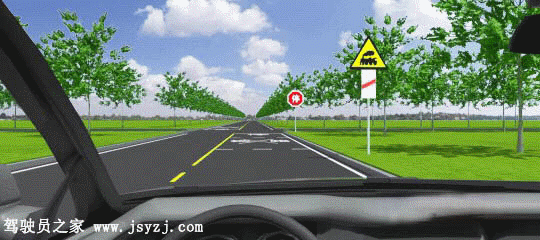1、When a motor vehicle passes over an inundated road, what should the driver do for safe driving?
A、Slow down and drive with special care
B、Speed up and pass rapidly
C、Maintain a normal speed and pass through
D、Change to a low gear and speed up to pass
Answer:A
2、Motor vehicles should accelerate when driving into an intersection with this traffic signal.

A、Right
B、Wrong
Answer:B
3、The sign on the left indicates vehicles are allowed to drive on the section ahead.

A、Right
B、Wrong
Answer:B
4、Which of the following is a basic requirement for rescuing the injured at the scene of a traffic accident?
A、Treat wounds first and safe life later
B、Save life first and treat wounds later
C、Help lightly wounded persons first
D、Help seriously wounded persons later
Answer:B
5、When the electric equipment and gasoline of a motor vehicle catches fire, the driver may extinguish the fire with water.
A、Right
B、Wrong
Answer:B
6、What should the driver do when he/she encounters an oncoming ambulance in the same lane?
A、Keep to the side and reduce speed or stop to yield
B、Drive ahead by occupying another lane
C、Yield by speeding up and changing lanes
D、Drive ahead in the original lane
Answer:A
7、Having driven his vehicle at 110km/hour on an urban road, Mr. Lin is trying to leave the scene after a rear-end collision but is held back by bystanders. The alcohol concentration in his blood, tested in an alcohol test by the traffic police, is 135.8mg per hundred milliliters. Which of the following law-breaking acts did Mr. Lin commit?
A、Drunk driving
B、Speeding
C、Fatigued driving
D、Hit-and-run driving
Answer:ABD
8、The sign on the right warns of a bumpy road ahead.

A、Right
B、Wrong
Answer:B
9、When parking for a long time on an upward slope due to breakdown on the road, drivers should use this method to stop up wheels.

A、Right
B、Wrong
Answer:B
10、After entering the acceleration lane of an expressway, the driver should increase the speed to how many kilometers per hour?
A、More than 30 km/hour
B、More than 40 km/hour
C、More than 50 km/hour
D、More than 60 km/hour
Answer:D
11、Under such circumstances, the motor vehicle is allowed to overtake.

A、Right
B、Wrong
Answer:B
12、The sign on the right indicates that the number of the lanes ahead will increase.

A、Right
B、Wrong
Answer:B
13、When approaching each other at night in this situation, drivers should watch for the danger where the two motor vehicles headlamps meet(the sight dead zone).
A、Right
B、Wrong
Answer:A
14、The sign on the right warns of no passing due to collapse on the road ahead.

A、Right
B、Wrong
Answer:B
15、The sign in front indicates a temporary parking lot on the right side of the highway.

A、Right
B、Wrong
Answer:B
16、Which lamp should be used when motor vehicles pass hrough an intersection at night where there is no traffic light signal?
A、High-beam
B、Low-beam
C、Hazard lamps
D、High-beam and low-beam should be used alternatively
Answer:D
17、When overtaking on a rainy day, drivers should turn on headlamps and sound a long horn.
A、Right
B、Wrong
Answer:B
18、Before driving, it is necessary to check whether the cooling liquid, engine oil and fuel oil, are leaking.
A、Right
B、Wrong
Answer:A
19、The sign on the right warns of a winding road to the left ahead.

A、Right
B、Wrong
Answer:B
20、As shown in the flash, the motor vehicle chooses a correct way to pass through the level crossing.

A、Right
B、Wrong
Answer:A
21、Drivers may turn left when traffic police give these hand signals.

A、Right
B、Wrong
Answer:A
22、How should lamps be used when motor vehicle drivers pass through a two-way tunnel?
A、Turn on the hazard lamps
B、Turn on the high-beam
C、Turn on the fog lamp
D、Turn on the low-beam
Answer:D
23、When braking, side skid or tail swing may occur if the rear wheels are blocked.
A、Right
B、Wrong
Answer:A
24、When a motor vehicle passes over an inundated road the driver should change to a low gear and pass at a constant speed.
A、Right
B、Wrong
Answer:A
25、Which of the following method is correct to rescue an unconscious person?
A、Apply cardio-pulmonaryresuscitation immediately
B、Press the philtrum of the wounded person with force
C、Continuously slap the face of the wounded person
D、Check the breath of the wounded person before other emergency treatments
Answer:D